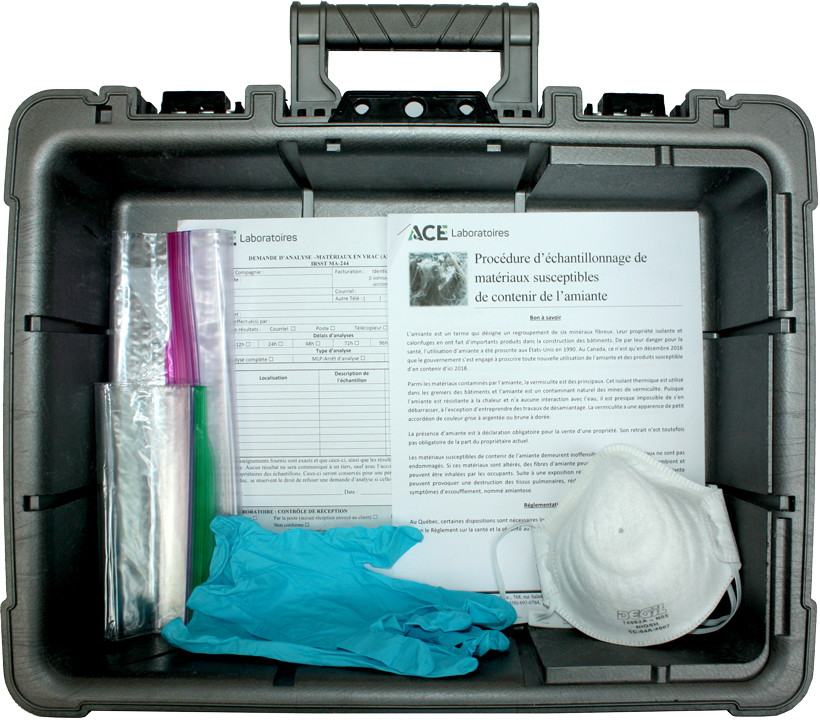- info@acelabo.com
- +1-450-693-0764
Material Analysis Likely to Contain Asbestos

ACE Laboratoires Inc. are known by the IRSST and certified by the AIHA through the trimestral proficiency test program of the BAPAT. The laboratory uses the IRSST 244 reference method advocating polarised light and color dispersion microscopy in order to quantify and identify the asbestos type susceptible to be present in several materials such as flocking, heat insulation, cement/plaster and vermiculite.
What is Asbestos?
Asbestos is a word used to designate six types of fibrous minerals; chrysotile, actinolite, tremolite, amosite, crocidolite and anthophyllite. In the years 1930 to 1980, asbestos was used for its isulation and fireproof properties.
Here are some examples of materials likely to contain asbestos:
- Construction materials (e.g. roofing shingles, roofing materials, ceiling and floor tiles, paper and felt products, exterior cladding, cement, plaster, joint compound).
- Thermal and flame-retardant protective clothing.
- Thermal insulation (e.g. vermiculite), electrical and acoustic insulation or packaging.
- Reinforcement elements for plastic products, thermoset resins and thermoplastics.
Vermiculite: insulation of the attic
Vermiculite is a thermal insulation used in building attic. Vermiculite is mainly made of mica, but might contain asbestos fibers, since it’s a natural contaminant of mica mines.
The vermiculite has the appearance of a small accordion from gray to silver or brown to gold.
Health Hazard
Materials likely to contain asbestos remain harmless as long as these materials are not damaged. If these materials are altered, asbestos fibers can be released into ambient air and can be inhaled by the occupants. Following repeated or prolonged exposure, asbestos fibers can cause destruction of lung tissue, reducing their elasticity and causing symptoms of shortness of breath, known as asbestosis.
As a health hazard, the use of asbestos was banned in the United States in 1990. In Canada, it was not until December 2016 that the government committed itself to proscribing by 2018 any Use of asbestos and products likely to contain asbestos.
https://www.canada.ca/en/health-canada/services/air-quality/indoor-air-c...

Regulation
In Quebec, according to the Occupational Health and Safety Regulations (the Occupational Health and Safety Act, chapter S-2.1, s. 223), "a material, a product, a flock or a heat insulator contains asbestos when the concentration of asbestos is at least 0.1% "(Article 69.2). In addition, it states that "Any asbestos dust or scrap of friable material with an asbestos concentration of at least 0.1% must be stored and transported in a sealed container" (Article 62). In fact, when materials are identified as containing asbestos and work involving these materials is considered, certain precautions must be made as set out in the Safety Code for construction work.
It should be noted that the presence of asbestos must be reported for the sale of a property. However, its withdrawal is not compulsory on the part of the current owner.
When to Request this Analysis
It is of interest to carry out an analysis of materials likely to contain asbestos before carrying out construction or demolition work. If materials do contain asbestos, special precautions must be taken before, during and after work to protect workers, occupants and the environment.
Sampling
Note: Always handle materials likely to contain asbestos by wearing gloves and a N-95 mask.
Accepted samples of material likely to contain asbestos must be of a minimum volume of one inch square (1 in3), submitted in doubled hermetically sealed plastic bags (e.g. Ziploc© bags).
For vermiculite samples, the equivalent of one cup (1 c) of the deep layer (scraping to collect the fine particles) must be taken from three different locations on the same surface and submitted in three plastic bags (Ziploc© sandwich format) hermetically closed, all packed into a larger bag, also hermetically sealed.
A Request for analysis must be completed and signed. If the sample is sent by mail, the Request for analysis and the samples must be put in a bubble bag or in a cardboard box.



